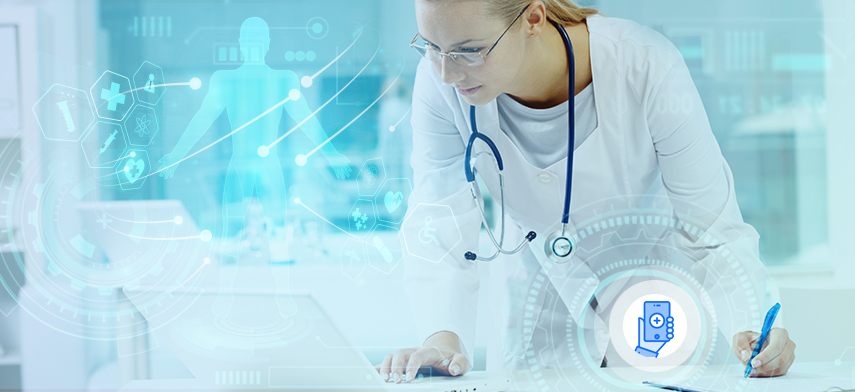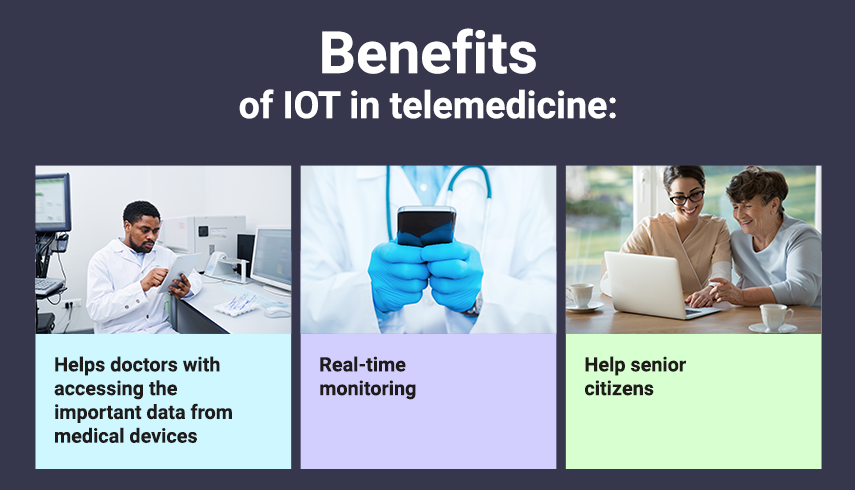The technology is growing unstoppably and benefiting the healthcare domain through telemedicine. Thus, the implementation of IoT would work in favor of the industry experts as well as the consumers. Coined by Kevin Ashton in 1999, the Internet of Things (IoT) took another decade to be implemented. It is an interconnected network of physical devices that run on the internet. These devices collect and share data. Computer chips and wireless communication networks can turn anything into IoT. Using sensors in these devices, they can become digitally intelligent.

Some common examples of IoT are digital home door locking system, remote/device controlled lighting system, and driverless cars. It comprises drones used for transmitting and collecting important data. Besides, it also includes fitness trackers that record the stats and displays on using a smart device, etc. In fact, the project of smart cities is also developing rapidly across the world, especially in developing countries.
How Is IoT Growing In Telehealth Industry?
IoT is here in every industry for its betterment and growth. And the healthcare industry is no exception. Use of IoT at a high scale in several healthcare treatment methods, equipment, IT communication between doctors and patients. It also improves other domains such as mHealth, telehealth, telemedicine, and so on.
Telehealth is remote monitoring of the patient and its key vitals. This allows the patients and doctors to be far away yet remain connected consistently with each other and get the required medical help on time. This is helpful for patients suffering from chronic illnesses or old age. It also helps the busy ones struggling with finding time to meet the physician in-person.
Telemedicine technology helps people located in remote areas or the ones who are unable to visit the doctors and hospitals due to factors like distance, age, or busy lifestyle. It provides remote care and virtual healthcare assistance, which is more affordable and convenient for healthcare professionals and patients. Telemedicine is also effective for people suffering from serious ailments such as kidney issues, heart ailment, respiratory diseases like chronic obstructive pulmonary disease, diabetes that requires constant monitoring by their doctors. This saves rushing to the hospital at the last moment, high expenses of readmission in the hospitals, and in rare cases save the patient from death by giving treatment remotely at the right moment.
Need For Telemedicine In Developing Countries And Rural Areas
With the increasing demand in the healthcare industry, telemedicine is gaining more popularity. The demand is also rising in under-developed as well as developing countries due to the current lack of healthcare facilities. With telemedicine technology, it would become easier for the patients to reach the healthcare providers remotely. The telecommunication companies are also working on providing a stronger network in remote areas, to make this successful.
At present, these areas lack qualified healthcare staff, which makes the handling of critical conditions difficult. This also results in increased fatalities and more deterioration of the patient’s health. Besides, hospital expenses and in-person consultation costs also add up to hefty expenditure. Thus, it would not be wrong to say that telemedicine technology is expected to revolutionize rural areas of developing and underdeveloped nations.
Now Let Us Understand How Is IoT Beneficial For Telemedicine
There are many ways in which the IoT can help in the growth of telemedicine by providing help to healthcare centers with improved quality of care. This has turned out to be better and more convenient in several in-person treatment methods. Some of the beneficial aspects of IoT in healthcare telemedicine are as follows:

1 Helps doctors with accessing the important data from medical devices
The doctors can look at the wound, rash, or skin color and analyze the patient. But, they are unable to listen to the patient’s heartbeat and check the blood pressure and other related vitals. This is a major challenge. In these cases, the IoT wearable devices play an important role where the doctors can access important information through them. Some of the healthcare centers are even developing their own IoT wearable for their patients to monitor their health. Additionally, oximeters and digital stethoscopes are the IoT devices used by the patients during telemedicine consultation and virtual meetings.
Thus wearing IoT devices is as important as it is to wear them correctly. This is so since, data quality and wearability are the two current challenges.
2 Real-time monitoring
Real-time monitoring technology helps doctors to get the patient’s details every second. Patients wear Holter monitor device to monitor the abnormalities in their heartbeat. Development in technology has enabled people to take care of their health with IoT and telemedicine.
3 Help senior citizens
Several elderly people prefer to stay at home in their last days in place of shifting to assisted living facilities. However, aging without any assistant facilities, and doing things on their own, also requires being aware of the resources like home delivery of meals, communities, social groups, emergency numbers, and knowledge about using certain devices. In such cases, telemedicine and IoT play an important role. Several household devices are under development to help senior people, to make living at home safer and hassle-free. Speech-enabled devices like Alexa, voice-activated speakers are some of the IoT telemedicine devices for the convenience of the people living at home. These devices are also helpful to guide people with disabilities.
Considerations For Successful Implementation Of IoT In Telemedicine
While implementing IoT in telehealth/telemedicine, there are certain aspects consider for success. The key aspects of these are:
Site readiness
The customers play an important role in the deployment of IoT on-site as far as readiness is concerned. The gap between the on-site authority and the production company’s management should be bridged to the optimum. Some of the last-minute hassles include power points, cable duct access, connectivity, device-cabling permission, and installation space. Besides, the unavailability of local help such as admin person, electricians, networking staff can also create delays in the final deployment.
Maintenance
With improper usage, or with the passage of time, the IoT device gets worn off and requires maintenance. Now, the services of these devices on time are a big challenge, as it needs to be done as quickly as possible. A lot of things are dependent on these IoT devices in telemedicine. So, in the customer-centric areas like hospitals, and other healthcare centers the urgency of these devices is high.
Deployment location
Usually, the IoT devices in telehealth are installed at remote customer locations or patient’s homes. So, it is safe to first inspect the site or the deployment location, for example, a range of IoT gadgets and its compatibility with other devices, availability of Wifi, room infrastructure, the direction of sunlight in the room, etc. Irrelevant half-known details collected by the field staff can lead to improper device installation plan.
Device operability and testing
It is very important to check for the proper operability of the IoT device used for telemedicine purposes. As these devices are installed in remote areas it becomes ever more mandatory to check the field condition and test the device working.
Security
IoT in telemedicine usually works on telecommunications and internet connections. Thus, it is very necessary to have a secure connection, particularly for Patient Identity Information (PII) and Patient Health Information (PHI). Security includes both, during the storage stage as well as transmission.
Device testing and support
When a device is not tested properly and lacks tech support might result in fluctuating expenses for logistics, along with the failed efforts for user satisfaction. The stages of device testing and support comprise:
- Connectivity
- Lifecycle Management
- Logistics
- Inventory Management
Trending Use Cases Of IoT In Telemedicine
In the past few years, IoT in telemedicine has come up with new opportunities in-patient care, which includes acute care, home care, and long-distance care. The increasing adoption of wearables and smart devices, along with improved network and internet connectivity. Let us have a look at some of the trending use cases of IoT in telemedicine.
iRemote patient monitoring
Remote patient monitoring is one of the most popular terms making rounds on the IOT platforms in the telemedicine market. The entire idea behind this concept is to reduce the hospital stay, in-person visits, and the overall healthcare expenditure. It also helps the patients who are unable to reach the physicians due to long-distance, poor health, or old age. This technology helps both, patient and the doctor to monitor the patient’s activities, and its impact on their vitals. For example, a well-known healthcare firm has innovated a remote diabetes monitoring solution, which constantly monitors the glucose level in the patient, after being inserted in their arm. The vitals can be simply monitored through the app installed in their smartphone with iOS or Android OS.
iiMobile health
As discussed the term mHealth or mobile health in our previous blog, it is needless to say that the innovation has turned up like a boon in the healthcare industry. The utter convenience to keep a track of all the required vitals of the body and get a detailed report on your smart device is one of the advanced developments in the field. The technology is integrated with the wearable devices that are connected to the application installed on the user’s mobile. This helps control several critical situations where the patient requires immediate treatment.
iiiIngestible sensors/devices
Many times patients tend to forget the doses of the prescribed medicine or get careless about them. This aggravates the health concerns and the treatment of the ailment takes more time than the usual, affecting the cost incurred as well as the criticality of the illness. To avoid this scenario, the ingestible sensors are discovered which goes inside the human system and stays at a particular spot. It can then detect the doses taken and missed based on the sensors. These smart pills also help reduce the senseless consumption of medicines which sometimes can even turn out to be fatal or life-threatening. These ingestible devices in their advanced version are now also available with a camera attached to them, which gives the inner view of the body parts and organs.
With So Many Advanced Applications Of IoT In Telemedicine, There Are Certain Drawbacks In The Field That Needs Attention. Let Us Have A Look At The Challenges In The Industry:
Unauthorized access
If the system does not have a strong security module, it might allow hackers and other interlopers to get access to the doctor and patient’s data. Needless to say, it can be dangerous as one may have ill-intents behind the access.
Privacy concerns
If a centralized system or even a single patient device is hacked, all the data can be available for the misuse and even the hacking of the entire system. This would not just affect the patient’s treatment but could also be very risky from the investment in the healthcare industry perspective.
Global healthcare policies
Currently, the healthcare policies around the world are in their transitional stage. In many states and countries, the healthcare centers and the government are still following the outdated regulations, which create an obstruction in implementing the technology for the proper treatment and other procedures.
Besides These, There Are Certain Issues To Take Care From The Device Point Of View:
Difficulty with regular updates
These IoT devices in telemedicine often require regular updating, which comes as a challenge for the users. Not all users are tech-savvy and thus, elderly people or the ones with a disability find it difficult to keep themselves updated with the latest version. This results in incomplete vital analysis and hampers the treatment.
Lack of sufficient memory in device
The developers and the companies are working on providing larger memory space and storage capacity in the devices. Sometimes, the lack of available memory results in incomplete storage of patient’s data. This later complicates the diagnosis process and obstructs further steps.
Underdeveloped initiatives
Since the industry is in its budding stage, several IoT in healthcare concepts are struggling with getting accurate results in case of chronic ailments and other critical issues. This can be overcome with time and further research and development.
These drawbacks, however, do not overpower the benefits of IoT in the telemedicine sector. There are several advantages that prove the usage of this technology to be useful and productive from the future perspective.
Here Are Some Of The Key Advantages You Should Have A Look Upon:
Lesser no-show rates
Since the patients do not have to visit the clinic in-person, it reduces the no-show rates caused due to busy lifestyles, bad weather, or poor health.
Gives a competitive edge to the companies over their competitors
Implementing this technology and encouraging your patients to adopt it definitely improves a company’s brand name and authenticity in the regional as well as global markets.
Increased revenue
Since technology comes with several benefits and less investment, it usually turns out to give better ROI to companies and hospitals.
Flexibility of working
The technology does not only give the patient a convenience to access the healthcare facilities from remote areas, but it also gives the doctors flexibility of working and treating patients remotely, without having to be present in the clinics all the time and make appointments.
Cost-effective
The doctors can increase the number of appointments in a day and can also scale up the patient count in general, with lesser efforts and less time. Also, the patient has to pay comparatively less of the consultation charges than the in-person visits.
Wider access to healthcare experts
Since the solution provides the list of specialists and physicians available for the consultation, it gives a wider range of healthcare professionals to the patients to choose from and get multiple opinions in one place.
Healthy healthcare staff as lesser direct exposure to illness
Since the physicians and nurses do not have to check the patients in-person, they save themselves from direct exposure and maintain their own health.

Wrapping up,
As the latest technologies keep on getting introduced in the healthcare sector, the IoT in telemedicine is also foreseen to witness substantial growth. Busy lifestyle and technological advancements both collectively are focussed on providing more comfort and convenience to patients as well as the doctors. Besides, it would not be wrong to say that it is giving a competitive edge to the companies in the industry, along with better ROI and recognition.

Author's Bio

Shoeb Ahmad, with an experience of 22 years in Digital World, heads Digital Marketing at Mobisoft Infotech. He has a rich experience in SEM, SEO, Social Media & other verticals of Digital Media. He also has been a consultant for a variety of industries, enterprises & startups. He loves reading & traveling. He often writes on various forums since he believes ‘Knowledge increases by sharing.’


